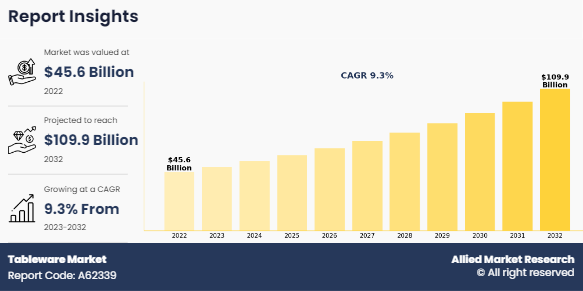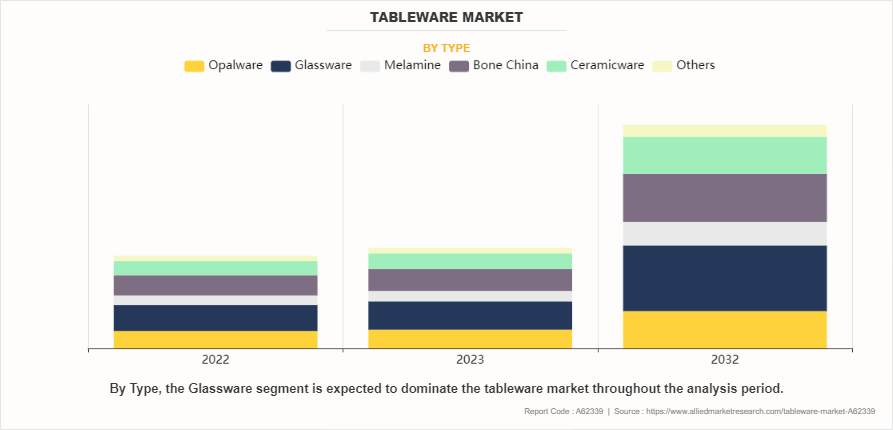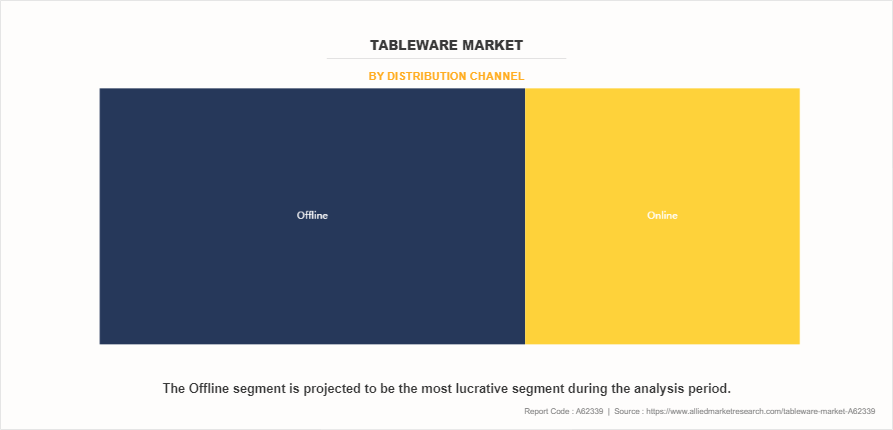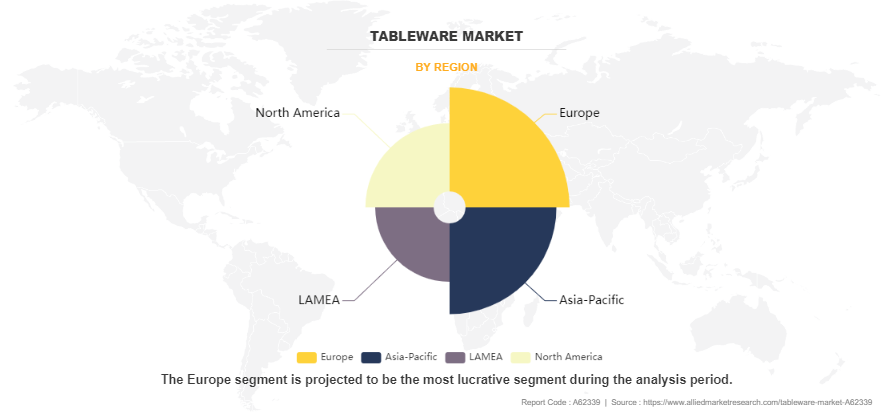Tableware Market Research, 2032
The global tableware market size was valued at $45.6 billion in 2022, and is projected to reach $109.9 billion by 2032, growing at a CAGR of 9.3% from 2023 to 2032.
Tableware refers to the assortment of items used for serving and consuming food & beverages during meals. It encompasses a wide range of products, including plates, bowls, glasses, cups, and utensils, designed to enhance the dining experience. From everyday use to special occasions, tableware reflects individual preferences and cultural traditions. Distinguished by materials, styles, and functionality, tableware serves as an extension of personal taste and hospitality.

The tableware industry has gained huge popularity in recent years owing to the aesthetic appeal, durability, longevity, and versatility offered by porcelain, ceramic, or luxury dinnerware. This is because quality tableware, whether porcelain, ceramic, or luxury dinnerware, offers timeless elegance and sophistication. The aesthetic appeal of well-crafted dinner plates and sets adds a touch of refinement to any dining occasion, from everyday meals to special celebrations. In addition, materials like porcelain and ceramic are fired at high temperatures, resulting in non-porous surfaces that resist chipping, staining, and wear over time. Investing in quality tableware ensures that the dining essentials withstand the test of time, reducing the need for frequent replacements.
Key Takeaways
- Based on type, the glassware sub-segment emerged as the global leader in 2022 and the ceramicware sub-segment is anticipated to be the fastest growing during the forecast period.
- Based on distribution channel, the offline sub-segment emerged as the global leader in 2022 and the online sub-segment is predicted to show the fastest growth in the upcoming years.
- Based on region, Europe registered the highest market share in 2022 and Asia-Pacific is projected to show the fastest growth during the forecast period.
Segment Overview
The tableware market analysis is segmented into Type and Distribution Channel.

By type, the glassware sub-segment dominated the global tableware market demand in 2022. Glass dinnerware sets offer a touch of elegance and luxury to any dining experience. With their stunning appearance and versatility, they are perfect for both special occasions and everyday use. Glass tableware is low-maintenance and easy to clean, making it a practical choice for busy households. Simply wash with mild soap and warm water, and the glassware will sparkle like new. From tempered glass to handmade artisan pieces, there is a wide variety of glass dinnerware sets available to suit every style and preference.
Serving meals in glass dishes adds an extra touch of elegance and sophistication to the dining table, elevating the overall dining experience. In addition, glass crockery sets are appreciated for their eco-friendliness and non-toxic nature. Unlike plastic or ceramic alternatives, glassware sets are recyclable and do not leach harmful chemicals into food, making them a safer and more sustainable option. These factors are anticipated to have a positive impact on the glassware sub-segment of the tableware during the forecast years.

By distribution channel, the offline sub-segment dominated the global tableware market share in 2022. Tableware is usually purchased offline as offline shopping offers the advantage of immediate product availability. Unlike online shopping, where one may have to wait 5 to 7 days for delivery, offline stores allow customers to walk in and purchase their desired tableware without delay. The ability to choose by physical experience is a significant benefit of offline shopping. Customers can touch and feel the products, assessing their quality and aesthetics firsthand before making a purchase. Furthermore, quick returns are another advantage of offline shopping. Customers can easily return or exchange tableware on the same day, eliminating the hassle of waiting for return shipping and processing, as often experienced with online purchases.
Moreover, the satisfaction derived from shopping offline, especially with friends or family, is unmatched. The joy of browsing through displays, receiving personalized recommendations from staff, and making immediate purchases contributes to a fulfilling shopping experience. Also, offline shopping remains accessible to individuals with limited knowledge of the digital world, including those in rural areas or with low digital literacy, who may find it easier to visit physical stores to fulfill their tableware needs without facing technological barriers.

By region, Europe dominated the global market in 2022. Tableware holds significant popularity in Europe for several reasons, deeply rooted in cultural, social, and practical aspects. For instance, European culture places a strong emphasis on dining as a social and cultural activity. Meals are often viewed as an opportunity for gathering with family and friends, fostering connections, and enjoying good food together. Therefore, there is an increase in demand for well-crafted tableware that enhances the dining experience, adding elegance and style to the occasion. In addition, Europe boasts a rich history of craftsmanship and artisanal traditions in the production of tableware.
Countries like France, Italy, and the UK are renowned for their exquisite porcelain, ceramic, and glassware, which showcase intricate designs and superior quality. This tradition of craftsmanship contributes to the allure of tableware in Europe, with consumers valuing the heritage and artistry behind each piece. Also, Europeans prioritize quality and durability in their tableware selections. With a preference for long-lasting and timeless pieces, they often invest in high-quality materials like porcelain, ceramic, and glass that can withstand frequent use and maintain their aesthetic appeal over time.
Competitive Analysis
The key players profiled in this report include Lenox Corporation, PITO, Steelite International, FIESTA TABLEWARE, PORCEL S.A., Dudson, La Opala RG Limited, Noritake Co., Ltd, Wedgwood, Villeroy & Boch, and Rosenthal GmbH. Acquisition, product launch, partnership, and business expansion are the key strategies adopted by the market players. For instance, in February 2024, Berry Superfos, the company that designs, develops, and manufactures innovative plastic packaging solutions launched reusable tableware range which is tailored to meet demands of the food service industry. Comprising reusable bowls and lids, the range prioritizes functionality and sustainability. Transparent lids allow attractive displays of meals, while stackable design facilitates efficient serving.
Market Dynamics
The quality tableware is designed to be versatile, seamlessly transitioning from everyday use to formal gatherings. Whether serving a casual family dinner or hosting a lavish dinner party, quality plates, bowls, and serving dishes cater to diverse culinary needs while maintaining their aesthetic appeal. Also, materials like porcelain and ceramic are free from harmful chemicals commonly found in low-quality plastics, ensuring that the food remains safe and uncontaminated. Porcelain, ceramic, and biodegradable options offer sustainable alternatives to single-use plastics, reducing environmental impact and promoting responsible consumption. These factors are anticipated to boost the tableware market trends in the upcoming years.
The fragility, safety concerns, and maintenance requirements associated with certain tableware materials such as glass, ceramics, and melamine to restrain the tableware market growth during the forecast period. Glass and ceramic tableware, though elegant and charming, are prone to breakage due to their fragile nature. This fragility not only poses a risk of breakage during handling but also increases the likelihood of accidental injury if shattered.
Certain materials used in tableware production, such as colored glazes in ceramics and melamine resin in imitation porcelain, raises safety concerns. Leaching of harmful substances or release of toxic compounds under specific conditions can compromise food safety and pose health risks to consumers. In addition, wooden tableware requires careful maintenance to prevent mold growth and ensure hygiene. Regular disinfection and proper storage are necessary to mitigate the risk of gastrointestinal diseases associated with mold contamination. These factors are anticipated to hamper the tableware market opportunities during the forecast period.
The increase in popularity of biodegradable tableware is anticipated to have a positive impact on the tableware market forecast. This is because biodegradable tableware aligns with the growing concern for environmental sustainability. Made from natural elements like sugarcane pulp, corn, and potato starch, these products decompose naturally without releasing harmful chemicals into the soil or waterways. In addition, the use of renewable plant-based materials such as sugarcane pulp and corn ensures that biodegradable tableware is sourced sustainably. Unlike plastics derived from finite fossil fuels, these resources are replenishable and do not deplete the Earth's natural reserves. Also, with plastic pollution wreaking havoc on marine ecosystems, biodegradable tableware offers a solution to mitigate this crisis. By reducing the reliance on single-use plastics, biodegradable alternatives help decrease the volume of plastic waste entering oceans and harming aquatic life.
Furthermore, biodegradable tableware contributes to the reduction of landfill mass by offering compostable alternatives. Unlike traditional plastic products that persist in landfills for centuries, biodegradable tableware can be composted at home, transforming into nutrient-rich soil within a matter of weeks. Switching to biodegradable tableware eliminates the risk of exposure to harmful toxins present in plastic products. By opting for natural materials, consumers can enjoy food without the worry of chemical contamination, making it a safer choice for both individuals and the environment. In addition, biodegradable tableware offers the convenience of disposability without compromising on durability. Products like sugarcane pulp plates are sturdy and resilient, making them suitable for various culinary applications.
Key Benefits For Stakeholders
- The report provides exclusive and comprehensive analysis of the global tableware market statistics along with the market forecast.
- The report elucidates the market opportunity along with key drivers, and restraints of the market. It is a compilation of detailed information, inputs from industry participants and industry experts across the value chain, and quantitative and qualitative assessment by industry analysts.
- Porter’s five forces analysis helps analyze the potential of the buyers & suppliers and the competitive scenario of the market for strategy building.
- The report entailing the market analysis maps the qualitative sway of various industry factors on market segments as well as geographies.
- The data in this report aims on market dynamics, trends, and developments affecting market growth.
Tableware Market Report Highlights
| Aspects | Details |
| Market Size By 2032 | USD 109.9 billion |
| Growth Rate | CAGR of 9.3% |
| Forecast period | 2022 - 2032 |
| Report Pages | 310 |
| By Type |
|
| By Distribution Channel |
|
| By Region |
|
| Key Market Players | PITO, Lenox Corporation, Wedgwood, PORCEL S.A., Steelite International, Villeroy & Boch, Noritake Co., Ltd, Dudson, La Opala RG Limited, FIESTA TABLEWARE, Rosenthal GmbH |
The global tableware market is driven by factors such as rising consumer demand for customized and sustainable products, technological advancements in manufacturing processes, and changing dining habits. Opportunities lie in offering personalized solutions, embracing innovative designs, and capitalizing on the growing trend towards eco-friendly and personalized dining experiences.
The major growth strategies adopted by the tableware market players are partnership, business expansion, and product launch.
Asia-Pacific will provide more business opportunities for the global tableware market in the future.
Lenox Corporation, PITO, Steelite International, FIESTA TABLEWARE, PORCEL S.A., Dudson, La Opala RG Limited, Noritake Co., Ltd, Wedgwood, Villeroy & Boch, and Rosenthal GmbH are the major players in the tableware market.
The glassware sub-segment of the type segment acquired the maximum share of the global tableware market in 2022.
The potential customers of the tableware market include household, restaurants, hotels, catering services, corporate offices, and others.
Current trends in the tableware market include a shift towards sustainability, customization options, innovative designs, and the resurgence of traditional craftsmanship.
Loading Table Of Content...
Loading Research Methodology...



